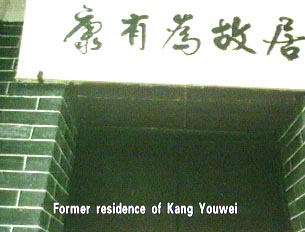 |
|
Delayed Reform (3)
The Natural Feet Movement |
| CCTV.COM 2002-05-17 07:05:38 |
|
 This was a big family who lived at the beginning of the 20th century. The girl in the photo looked innocent, but she had bound feet. A pair of feet, a jar of tears. Keeping bound feet had been the lot of Chinese women for more than one thousand years since the Song Dynasty. Eighty-two-year-old Ha Shuqin has painful reminiscences. This was a big family who lived at the beginning of the 20th century. The girl in the photo looked innocent, but she had bound feet. A pair of feet, a jar of tears. Keeping bound feet had been the lot of Chinese women for more than one thousand years since the Song Dynasty. Eighty-two-year-old Ha Shuqin has painful reminiscences.
Ha Shuqin, 82-year-old, said "My feet were bound. The end was stitched up. It gave me a lot of pain. My mother beat me if I took off the bandages. The pain was gone after the bones had been broken. How many years did it take? It took quite a few years. The bones were broken. The toes were twisted."
On a foreign postcard printed towards the end of the Qing Dynasty, Chinese women's feet were compared with their hands.
The foreigners were astonished to find that the feet were smaller than the hands. As a symbol of China's feudal society, binding feet meant that women in China were always a sight enjoyed by men. From the small shoes collected by the museum, we can feel the abnormal aesthetic habit.
At a girls' school in Shanghai, teachers began to pass on the concept of women having their position between heaven and earth. There arose a desire of self-consciousness among Chinese women, but Madame Curie in Europe had already won the Nobel Prize for Physics.
In the 19th century, many missionaries began to appear in various parts of China. While preaching the Gospel, some missionaries made the initial efforts to abolish the practice of binding feet. They met with a quick response from people of insight in China.
In 1893, Kang Youwei and some enlightened country gentlemen in Nanhai, Guangdong Province formed the Society Against Feet-Binding, declaring war on the bad custom that caused severe injuries to women. His student Liang Qichao published an article in the newspaper The Times to build up great momentum.
 They promoted the establishment of the Society Against Feet-Binding in Shanghai, evoking strong repercussions from all sectors of society. They promoted the establishment of the Society Against Feet-Binding in Shanghai, evoking strong repercussions from all sectors of society.
During the Reform Movement of 1898, Kang Youwei submitted a memorial to the Emperor, bitterly criticizing the harmful practice of binding feet and calling for a ban on it all over the country. In fact, the people's spontaneous Natural Feet Movement was a difficult enlightenment movement. The Reform Movement came to a premature end, but the Natural Feet Movement struck its roots deep down into the hearts of the people.
In 1901, following the wishes of the people, Empress Dowager Cixi issued the first imperial edict to advise women against binding feet. This was the first step taken to carry out new policies.
 With the joint efforts of the government and the public, the bad custom of binding feet gradually died out. The fate of Chinese women changed radically. The first women's games were held in Shanghai in 1906. With the joint efforts of the government and the public, the bad custom of binding feet gradually died out. The fate of Chinese women changed radically. The first women's games were held in Shanghai in 1906.
The old days brought many regrets to old women with bound feet who are still alive today.
Ha Shuqin is fond of making small tiger-headed shoes. She gives them to kids she knows. Maybe this is a psychological compensation for her.
|
|
|
|
|
|
|
 |









